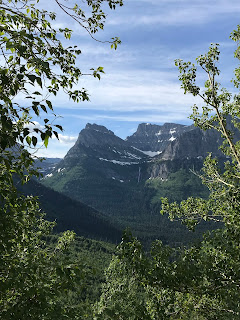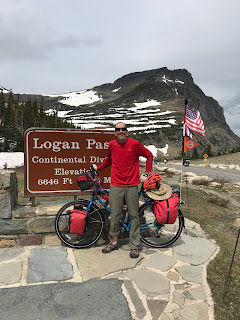
At 7am on June 28, 2018, three weeks and 650 miles into my solo cross-country bicycle tour, I started to climb the renowned Going to the Sun Road. I was hauling 165 lbs of myself, 30 lbs of Cassie (my bike), and 45 pounds of gear up to Logan Pass at 6646 ft. A total of 240 lbs.
I had been watching the Park Service website as I approached the weeks before because the road was not yet open due to snow. If it didn’t open, I would have to find another route over the Rockies. Since its completion in 1932, the latest Going To the Sun has ever opened was July 4. This year, it opened June 25th, two days before I got there.
Going to the Sun Road is closed to cyclists on the last 12 miles of the Western ascent of between 11am and 4pm because that’s when motor-vehicle traffic is heaviest (large vehicles and trailers are prohibited altogether). There is no restriction for westbound (descending) cycle traffic; nor is there any restriction on the eastern side of the pass. The road is very narrow. Most of it has a sheer drop-off on one side, and a stone wall on the other, which sometimes leans out over the curvy steep road. There is even one short tunnel. Periodic “turnouts” were built-in for slow-moving vehicles to allow traffic to pass. The Park Service estimated that the last 12 mile stretch would take about 3 hours by bicycle. Four miles per hour. Easy. HA!


Cyclists who don’t plan to reach the summit by 11am, would have to wait at the bottom until 4pm. There are no services along the way. Nor are there any services or camping at the pass, just a visitor center -- and fantastic views.
If I waited until 4pm to begin, that would ostensibly put me at the top at 7pm. Not wanting to then have to descend the other side, find a campsite, set up and eat all before sunset, I needed to reach the summit by 11am.
And I almost did.
I had camped at the Avalanche Creek campsite, the closest to the bottom of the restricted 12 miles. I was up early, ate, struck camp, and had foot to pedal by 7am, a record for me. It was clear and cool. But I hadn’t realized I was still four miles from the restricted area. No big deal. Those four miles were a very gentle incline. By 8am, I was three miles into the bike-limited stretch. I had three hours to go 9 miles. Easy. HA. HA!
I decided to stop every half hour, alternating breather-breaks with belly-breaks (as I called “having a snack”). The distance traveled between each break was getting shorter and shorter. The grade stayed very steady at six-percent, and it never changed. Literally. There was not one section, not one pedal-stroke, not one inch of downhill -- or even flat -- road. But the views were amazing. Around each corner, was another breathtaking sight. I didn’t have time to stop and and take a picture every time I felt the urge, but I almost always snapped one at the breaks.


There were no other touring cyclists laden with gear, but I was passed by several road-cyclists types, with minimalist equipment, and super light bikes. Ultimately, I would see them coming back down again. For them, it was just a really arduous UP followed by a really fun DOWN!
Three ladies fitting that description stopped at the same place I had. Jenny, Sherry, and Susie were impressed that I was hauling all that gear, and we chatted for a bit.

About an hour later, all three whooped and hollered as they zoomed by on their way down.
“You're almost there, Doug! Keep going!” The encouragement helped, as I plodded along.
The air was getting thinner. I was going slower and slower. And it was getting cold. Between the 10 and 10:30 breaks, I had only gone a mile. And I had three more miles to go. The day before, I had asked numerous park officials what happened if a rider didn’t make it. Would they turn me around? Would they give me a ticket? Would they push me off the edge? No one seemed to know.
These 61-year-old Ohio Buckeye lungs were not used to the thin air above five thousand feet (and climbing). I kept going. At the 11am cut-off, I was still a mile and a half from the top. There was no choice but to keep pedaling.
Shut-up legs! Shut-up lungs! Now I had to take a break every 15 minutes. The temperature had dropped to 42 degrees.
At last I saw a sign saying “Logan Pass ½ mile.” What a great sign! I stopped and took a picture, it was such a great sign. I was going to make it! About one hundred yards later the road bent sharply to the left. There was turnout to the right with several parked cars. A stern looking ranger was glaring at me. From there I could see the pass under half a mile away.

The Ranger waved me over. “We have to talk,” He intoned. “The restriction started half an hour ago.”
“Oh, so I guess it’s 11:30,” I said (though I knew). “I started at Avalanche at 7am, thinking I had plenty of time, but it sure is a tough climb.” My plea for sympathy was going nowhere.
He didn’t look happy. He asked for my ID, then stepped away and spoke into his special Ranger Radio. He clearly didn’t want me hearing his conversation.
Just as he signed off, a mountain goat appeared out of nowhere and started down the road. The Ranger gave chase, hollering over his shoulder, “I’ll be right back.” With that, he trotted down the road after the goat, with my ID. Apparently, one of a Ranger’s duties is to shoo wild-life off the road. I wasn’t sure what he intended to do if he caught the goat, but it didn’t matter because the goat had no intention of being caught. Nor was I sure what he intended to do with me. Down the road the Ranger went, chasing after the goat.

NOT the actual goat!
I realized that for every step he chased that goat, he would have to climb back UP the road. So I found a perch on a stone ledge and waited. I could see in the distance that the goat finally veered off into the wild and was gone.
He was back on the radio as he made his way back up the hill, signing off as he approached. I stood up. He wasn’t even winded.
“You got lucky, we're just going to give you a warning. If there are any other infractions, you will be cited,” he proclaimed, handing back my ID. He was all business.
“Thank you. I assure you there will be no other infractions.” The other side of the pass has no restrictions I couldn’t “infract” if I wanted to.
“Had I seen you down the hill at eleven o’clock, I would have turned you back.”
“Thank you again.” I replied. Turned back? With under two miles to go? That would have been a disaster. Sure, if I were one of the joy-riding UP and DOWN cyclist, it would be no big deal, but I was riding through. I wondered if the Ranger would have let me wait there at the turnout until 4pm when the restriction was lifted.
He looked confused when I asked if I could take his picture, but apparently couldn’t think of a reason not to let me. He even managed to look pleasant.

With that, he let me continue. The extended break (while he was chasing the goat) did me good, and I scampered up that last four tenths of a mile like -- forgive me -- a mountain goat!
I did it! Albeit not within the allotted time. It was the most arduous and satisfying single-day physical achievement I had ever accomplished. I took a long, very-well deserved break at the top. No food or beverages were available, but they had restrooms. The large parking lot was packed with automobiles. There was only one other bicycle. The rider was a young cyclist from Canada -- Rachel -- who had just come up the other side. She was planning to camp in the same site I had just come from -- Avalanche Creek. I ended up staying at the same place she had stayed the night before, so we just swapped campgrounds, both climbing the Going to the Sun Road from opposite directions.


The trip down the other side was wonderful (I’d been anticipating it for 5 hours). Unlike the West side, which was unyielding in its ascent, there were a few ups and downs on the East side. The previous year’s fires ravaged more of that side and much of the ride was directly through that aftermath. I could still smell the fire a year later.
By mid-afternoon, I reached the St. Mary campground, near the Eastern Portal, but still within the park.
Did the ranger decide to let me go on because he felt bad I had to wait while he chased a mountain goat? I wasn’t about to ask him. Nonetheless, I’d like to thank that goat.
No comments:
Post a Comment